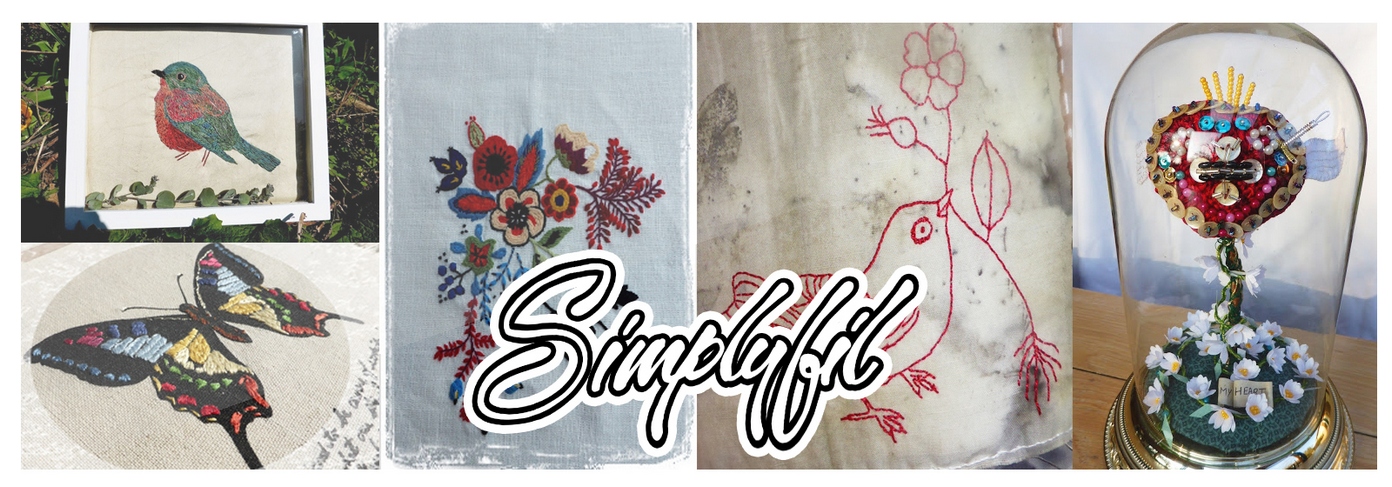Avertissement : cette méthode ne conviendra pas aux personnes qui aiment la symétrie ;-D
Rien n'est mesuré précisément et l'objectif est justement d'obtenir un carré un peu irrégulier pour un effet vintage !
Warning : people who love and need precision won't like this technique because it is precisely made to get a vintage and shabby effect !
You will need : dark and light colored strips fabric of about 1.5 cm width, some sewing thread and a rather thin needle, a square of thin fabric on which you will sew the stripes that must be the size of the block you want to make (so I'm recycling an old fabric and my block will be 15x15 cm) and a small square of fabric that will be the center of the log cabin block.
Vous aurez besoin de bandes de tissus claires et foncées de environ 1.5 cm de large, du fil à coudre, une aiguille assez fine, un carré de tissu fin sur lequel vous allez coudre vos bandes de tissus au dimension du block que vous souhaitez faire (moi je recycle un vieux tissu et mon block mesure 15x15 cm) et une petit carré de tissus qui sera le centre de votre block.
Pin the square in the centre of the block (I will sew on the wrong side of the fabric so that the design won't show through the light-colored strips )
Epinglez le petit carré au centre de votre grand carré (je vais coudre sur l'envers de mon tissus pour que les motifs ne soient pas visibles a travers les bandes claires)
Place a light colored strip on the wrong side along the border and the right corner of the square.
Posez une bande de tissu clair à l'envers sur le carré central le long du coin supérieur droit et du bord supérieur
Start sewing little running stitches from the right hand corner of the little square ...
Commencez à coudre au point avant en partant du coin supérieur droit....
...to the left hand corner where you will make one or two back stitches to block the thread.
...jusqu'au coin supérieur gauche où vous ferez un ou deux point arrières pour bloquer le fil.
Cut the remaining bit of strip of fabric along the border of the square...
Coupez le reste de la bande de tissu le long du bord gauche du carré central...
...raise the strip you have just sewn and flatten the seam with you nail.
...soulevez la bande de tissu que vous venez de coudre et aplatissez la couture avec votre ongle.
Turn the block clockwise and place another strip of light colored fabric along the border.
Tournez le block dans le sens des aiguilles d'une montre et positionnez une autre bande de tissu clair le long du bord comme précédemment.
Your thread will be under the strip so go through the two layers of fabric to start your seam in the right-hand corner and sew the same way as the first strip.
Votre fil va se trouver sous la bande précédente donc vous devrez traverser les deux épaisseurs de tissus pour commencer votre couture dans le coin supérieur droit et cousez jusqu'au coin gauche comme pour la bande précédente.
When you have raised and nail-ironed the second light-colored strip, turn your block clockwise and get ready to sew a dark colored strip...
Quand vous aurez cousu et rabattu votre deuxième bande de tissus clair tournez votre block d'un quart de tour et préparez-vous à coudre une bande de tissu foncé...
..starting from under the fabric as before.
...en partant du dessous comme précédemment.
Turn your block again and add a second dark colored strip and you will have finished you first round.
Tournez encore votre block et ajoutez une deuxième bande de tissu foncé et vous aurez fini votre premier tour.
Add another round still going clockwise being careful to use two light colored strips followed by two dark colored strip to get a block that will be dark colored on one half and light colored on the other.
Ajoutez un autre tour en tournant votre block toujours dans le sens des aiguilles d'un montre en faisant bien attention d'utiliser deux bandes de tissus clairs suivies de deux bandes de tissus foncés pour obtenir un block avec une moitié foncée et une autre claire.
Go on this way until you reach the borders of the block and don't worry if your strips are a bit bigger than the block, you can trim the excess off after ironing.
Continuez ainsi jusqu'à atteindre les bords du block. Ne vous inquiétez pas si vos bandes de tissu dépassent du tissus qui sert de support, il sera facile de couper ce qui est en trop une fois le block repassé.
et voilà !
As you can see on the photo my block isn't perfectly symmetrical but it has the right dimensions for the final assembling.
With this technique you can recycle many different fabric that only need to me about the same thickness like worn out shirts or pillowcases !
Comme vous le voyez sur la photo mon block n'est pas tout a fait symétrique mais cela ne l'empêche pas d'être aux bonnes dimensions pour l'assemblage !
L'avantage de cette technique est que l'on peut recycler tous les tissus qui sont a peu près de même épaisseur y compris les chemises ou les taies d'oreiller usées !
Il ne vous reste plus qu'à partir en promenade sur le web pour décider de votre assemblage final, comme ICI et LA.
















